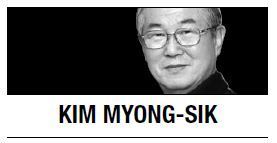[Kim Myong-sik] SLBM, THAAD and yellow jumpers around the table
By 김케빈도현Published : Aug. 31, 2016 - 16:32
 The hottest summer in everyone’s living memory has finally receded. Electricity consumption soared for cooling, but, thankfully, the nation avoided a feared “blackout” situation as most power stations, including nuclear plants, were in normal operation and people minimized the use of air conditioners in fear of bloated energy bills.
The hottest summer in everyone’s living memory has finally receded. Electricity consumption soared for cooling, but, thankfully, the nation avoided a feared “blackout” situation as most power stations, including nuclear plants, were in normal operation and people minimized the use of air conditioners in fear of bloated energy bills.So, in the area of power demand and supply, we achieved balance between individual needs and national capacity. It primarily was the steeply progressive utility rates that kept consumers from liberally using their air conditioning, but there also was public caution not to pass the red line in nationwide power supply, which allowed the Korea Electric Power Corp. to do its job without a hitch.
Having passed the adversity posed by Mother Nature, the Republic of Korea still has other troubles to confront in 2016. Worst of all, North Korea’s speedy advancement of its nuclear and missile capabilities, now boasting a submarine-launched ballistic missile, drove the security situation here to crisis level. Equally worrisome is the sharply split reaction in the political community, with oppositionists withholding words of condemnation.
The die-hard resistance of the people of Seongju against the installation of the THAAD anti-missile system, and that of the nearby Gimcheon residents, demonstrates the absence of common recognition of the peril that befell the whole nation. They do not know that Seongju is only the first to be chosen; many more places of South Korea will eventually have to have some kind of missile defense facilities if we are to survive missile barrages from the North.
It is of no use to deplore what little have we done over the past 20 years while Pyongyang took such great strides in developing weapons of mass destruction. Five administrations have taken turns governing this republic from the 1990s with varying emphasis in their respective security policies. Alternating liberal and conservative governments had drastic shifts in security agenda in accordance with their political orientations toward the North.
More attention was paid to the largely theoretical question of when Korea should take over full operational control of the allied forces (including wartime command authority) than the real problem of coping with the North’s rapidly growing WMD capabilities. Korean and US authorities consumed much of their energy on relocating USFK units southward away from the DMZ and negotiating how to share the cost of the American forces’ stationing here.
Faithful to the international nonproliferation regime, we remained at zero capability in nuclear arms and are barred from reprocessing the spent fuel from the many nuclear power plants. Korea’s ballistic missile development, bound by the international Missile Technology Control Regime and a US-set guideline, only barely gained the extension of permissible range to a circle that covers the whole North Korean territory a few years ago, with the maximum range still limited to 800 kilometers.
These restrictions have been justified and accepted here in exchange for Washington’s pledge of “extended nuclear deterrence.” Pyongyang’s SLBM demonstration with dramatic visual effect now stirs people’s trust in the effectiveness of the bilateral alliance, which is the very foundation of our security posture.
President Park Geun-hye held on to her routine amid the North’s SLBM shock, hosting a luncheon meeting with Olympic athletes and attending a “creative economy festival” at a university to encourage young engineers. It was reassuring that the head of state looked undisturbed by the North’s heightened threats, but her style of “business as usual” could lead the people to wonder how deeply the president was feeling the impact of the North’s escalating belligerence.
The president did call a session of the standing committee of the National Security Council hours after the SLBM launch to ask top military and security officials to be prepared of the North’s further provocations. These officials sitting around the president in the Blue House “bunker,” all in their emergency outfit of yellow jumpers, had predicted “four to five years” as the time needed for the North to finalize its SLBM program when an earlier launch apparently failed.
A faulty estimate of the enemy’s speed of advancement causes big trouble on the battlefield. If we in the South may have become insensible to the steady rise of threats over the decades, the SLBM launch struck a big alarm bell to us all -- from the president and NSC brass to the angry people of Seongju and Gimcheon with red headbands.
In democracy, spontaneity is important both in the exercise and restraint of rights in the course of overcoming composite difficulties like those that confront us today. All sectors need to exhibit societal discipline toward a common objective, a little more than we did in trying to avert a power blackout in the summer. The rest is up to the government and president -- to strengthen independent defense power, solidify alliances and engage neighbors in practical diplomacy.
I hate to admit it, but we, the free, richer South, completely lost to the North in a quiet war: the arms race on the peninsula. We cannot afford to remain the losing side any further, knowing the dire consequences.
By Kim Myong-sik
Kim Myong-sik is a former editorial writer for The Korea Herald. He can be reached at kmyongsik@hanmail.net – Ed.



![[KH Explains] Hyundai Motor’s plan for new landmark keeps hitting bumps](http://res.heraldm.com/phpwas/restmb_idxmake.php?idx=644&simg=/content/image/2024/05/13/20240513050626_0.jpg&u=20240513192803)



![[Grace Kao] American racism against Stray Kids](http://res.heraldm.com/phpwas/restmb_idxmake.php?idx=644&simg=/content/image/2024/05/13/20240513050827_0.jpg&u=)



![[Graphic News] Over 80% of people filing bankruptcy in Seoul in their 50s and older](http://res.heraldm.com/phpwas/restmb_idxmake.php?idx=644&simg=/content/image/2024/05/12/20240512050205_0.gif&u=)






